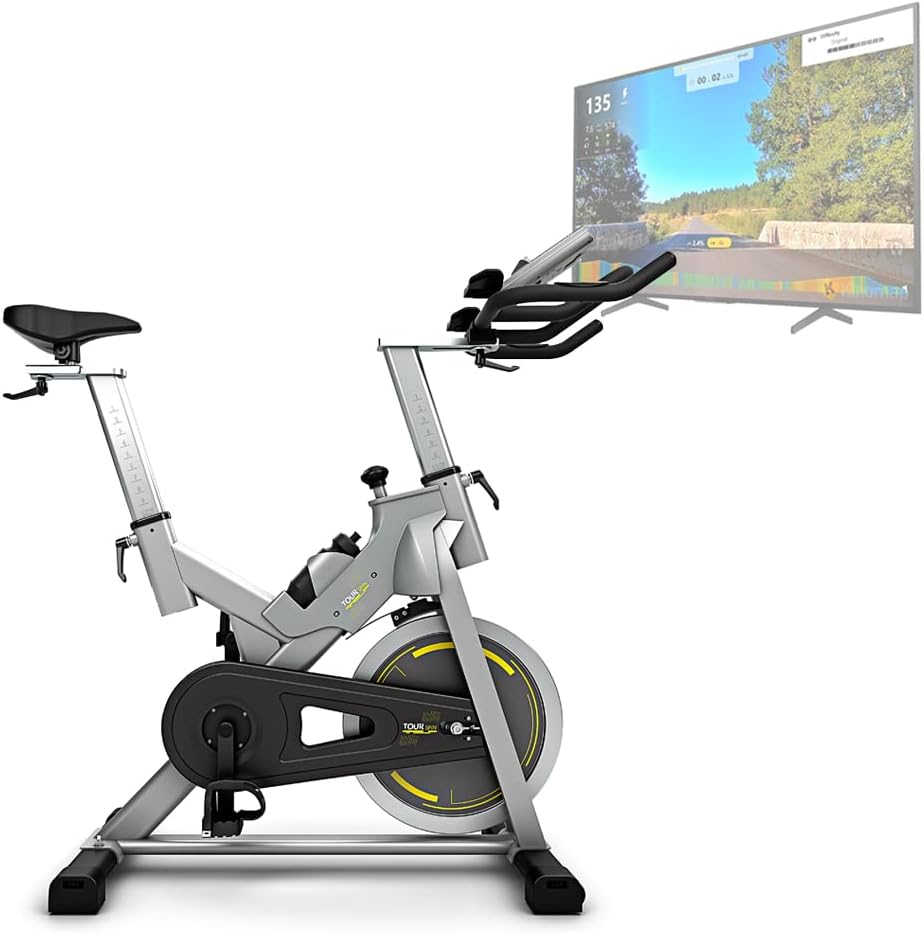Alternatives to Turbo Trainers for Indoor Training Apps like Zwift and Wahoo
 Karen Parnell
November 30, 2023
Karen Parnell
November 30, 2023
Alternatives to Turbo Trainers for Indoor Training Apps like Zwift and Wahoo
We will explore the alternatives like spin bikes, rollers and power pedals
In recent years, indoor training has witnessed a revolution with the rise of popular apps like Zwift and Wahoo, turning the tedious task of stationary cycling into an engaging and immersive experience. While turbo trainers have been the go-to choice for many, there are alternative options that can elevate your indoor training game. In this blog, we will explore alternatives like spin bikes and power pedals, offering you a diverse range of choices to make your indoor workouts more exciting and effective.
Spin Bikes: Riding into Realism
Spin bikes provide a dynamic alternative to traditional turbo trainers, offering a more immersive cycling experience. Unlike fixed turbo trainers, spin bikes come with built-in resistance mechanisms and a freewheeling design, mimicking the feel of outdoor cycling. Some spin bikes also feature smart technology compatibility, allowing them to sync with popular training apps like Zwift and Wahoo. This creates a realistic and interactive training environment, adjusting resistance based on the virtual terrain in the app.
I personally find that the robustness of a spin bike enables me to cycle out of the saddle easier with more stability than a smart turbo trainer. I also found that a spin bike takes up less room that a standard bike and turbo trainer set up. The other advantage is that you have a dedicated indoor training set up without having to use your road bike or TT bike.
Spin bikes can also be more flexible as anyone in your household can jump on and adjust the seat and handlebar height to suit them and start using Zwift or Wahoo.
The other major benefit is that you can pick up a second-hand spin bike for not much money and even a new one won’t break the bank.
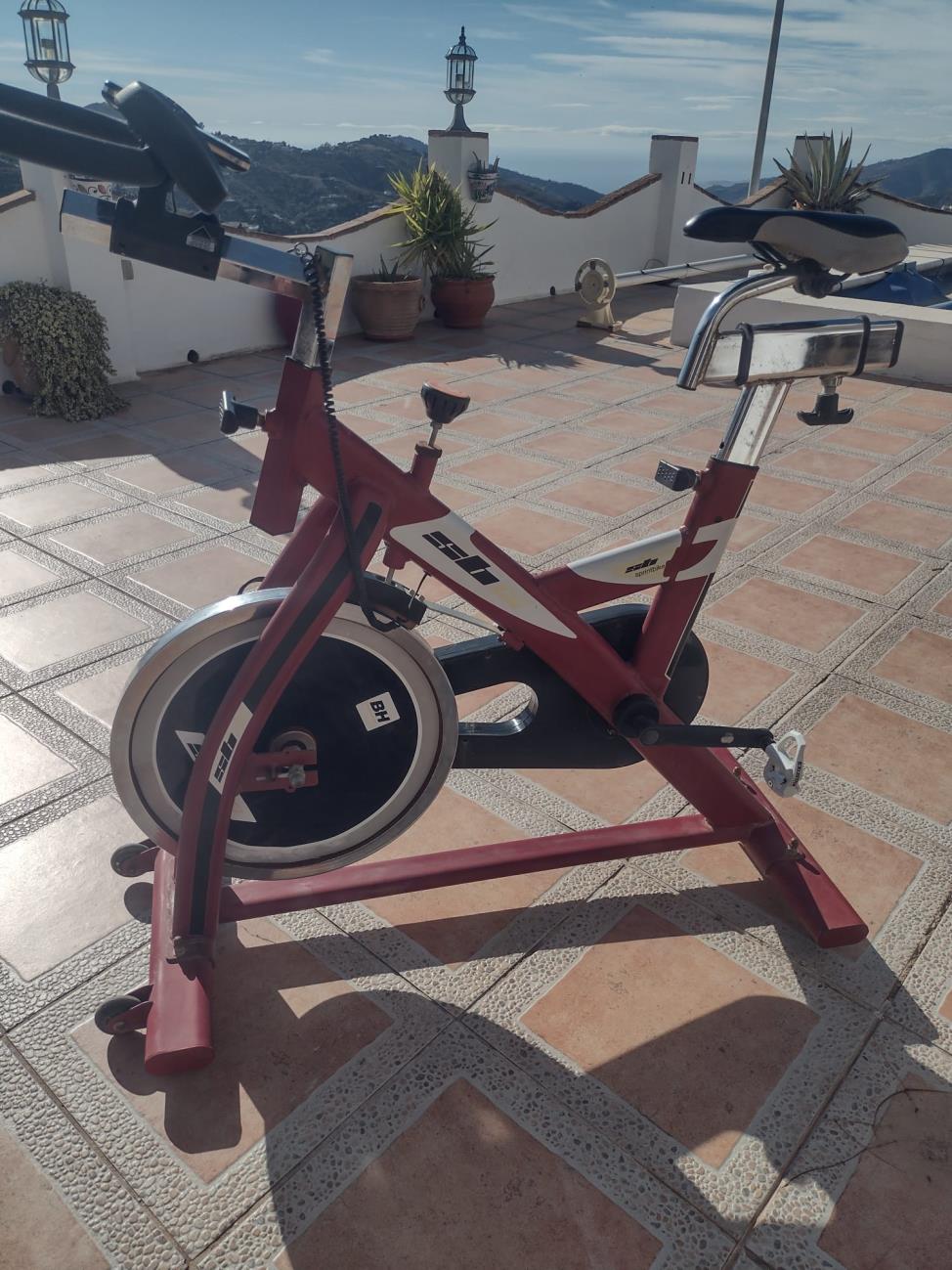
The BH spin bike I will used to test the speed and cadence centre and power pedals
FREE DOWNLOAD: 31 Structured Indoor Workouts for Zwift, Rouvy and TrainerRoad
Making a Spin Bike “Smart”
You can take a standard spin type bike and turn it in to a smart bike. Making a spin bike smart involves giving the ability to send speed, cadence or power data to the App via Bluetooth or ANT+. Here are two ways to do this.
Adding a Speed and Cadence Sensor to your Spin bike
Adding the ability for your spin bike to output speed and cadence needs by Zwift is a relatively easy and not very expensive.
The speed and power sensors should cost less than £30 and you will need to make sure that there are two sensors – one for speed and one for cadence – due to the way they need to be mounted on a spin bike.
An example are the ones from Moofit on Amazon, this is the one I used.
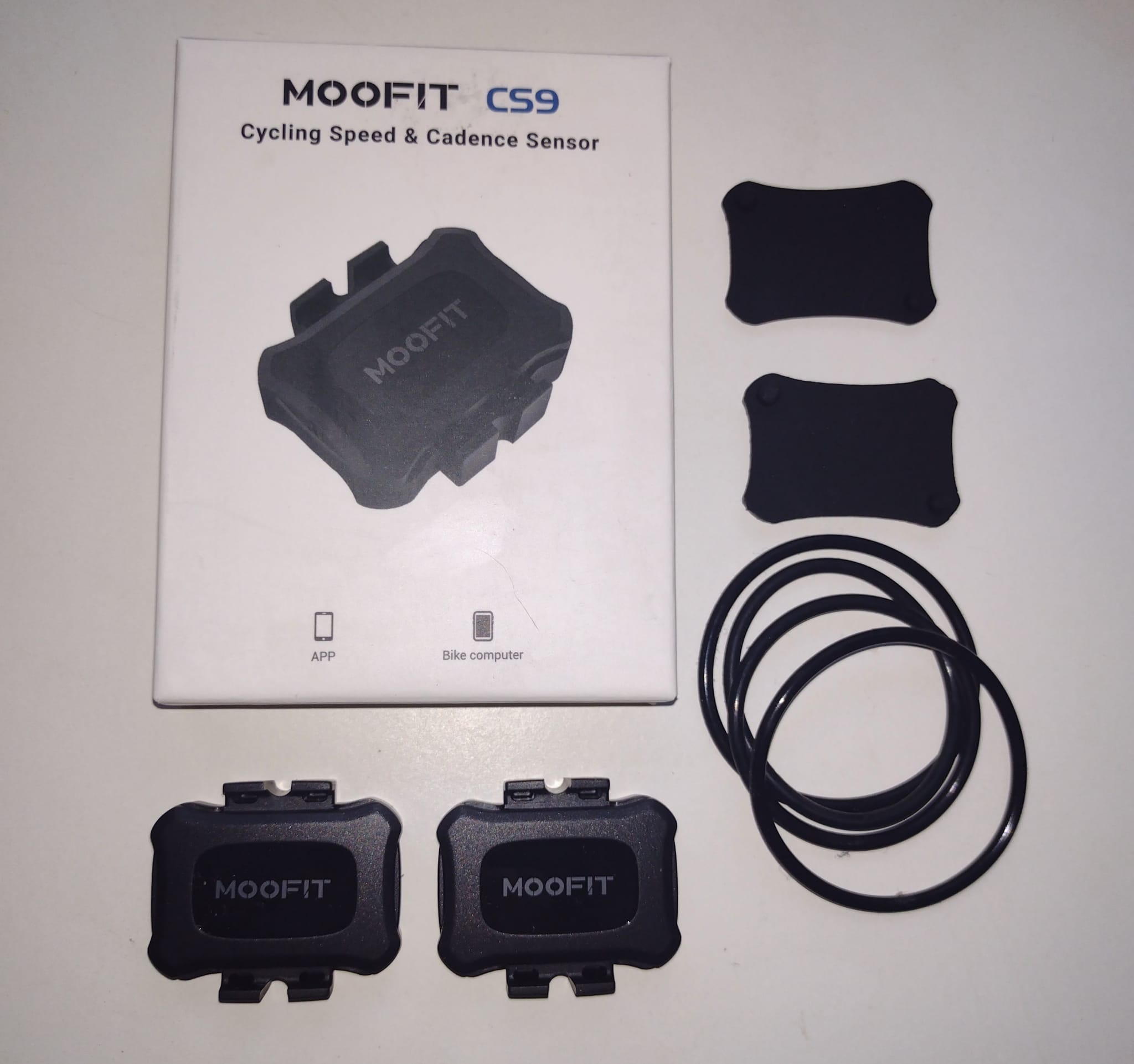
The Moofit Speed and Cadence Bluetooth Sensors
This website uses affiliate links which may earn a commission at no additional cost to you. As an Amazon Associate I earn from qualifying purchases.
The cadence sensor is straight forward and mounts on the bike pedal arm like a standard bike. For the Moofit device make sure the LED light is blue for cadence mode.
The video below shows how to fit the cadence sensor to a spin bike.
How to fit a standard Wahoo cadence sensor to a spin bike
The speed sensor is slightly trickier depending on your spin bike as it normally fits to the front wheel on the hub. On a spin bike there is no hub so your need to mount the speed sensor on the flywheel.
The video below shows how to do this:
Fitting a Wahoo speed and cadence sensor to a spin bike
I had to glue a cube of foam to my flywheel and sit the sensor one this to get it in the right orientation. For the Moofit make sure your speed sensor LED is red. I was able to connect these two sensors plus my Wahoo TICKR heart rate monitor to Zwift and use virtual calculate power to ride around the Zwift worlds.
Now you have speed and cadence on your spin bike you can connect to Zwift etc and enjoy a workout. I would also recommend wearing a heart rate monitor to collect as much data about your ride as possible and I would recommend the Wahoo TICKR heart rate monitors which have both Bluetooth and ANT+ so you won’t run out of connection options.
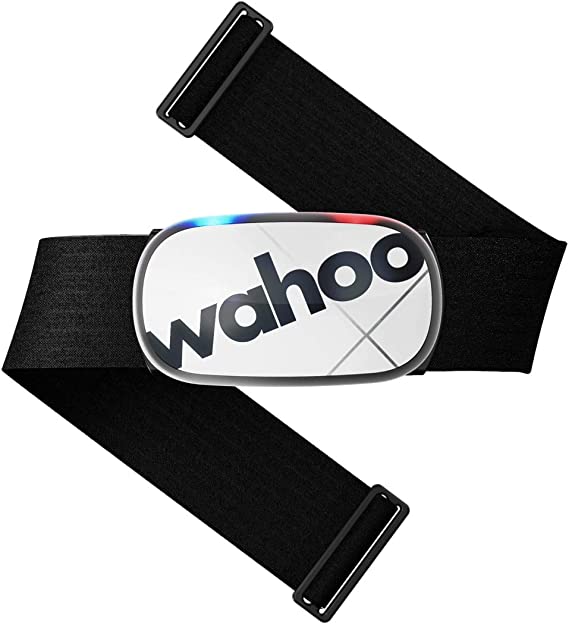
The Wahoo TICKR-X Heart Rate Monitor
FREE DOWNLOAD: 31 Structured Indoor Workouts for Zwift, Rouvy and TrainerRoad
If you are using a PC to run your training App you may also need to use an ANT+ dongle and cable to get the dongle close to you the sensors on your bike. I use the Coospo ANT+ dongle and cable.
WAHOO SYSTM Setup
I have tried to use this speed and cadence set up with Wahoo SYSTM and they say that this is possible, but they do not support virtual watts. They suggest RPE (Rate of Perceived Exertion) plus other connected sensors which involves using a heart rate monitor and cadence sensor. This setup requires you to also use Rate of Perceived Exertion (RPE) to manually adjust your resistance to match the power profile and workout targets. You can read more about how to do this here on the Wahoo website.
Using Power Pedals to connect a Spin bike to Zwift, Wahoo and other Workout Apps
Power pedals are another innovative alternative that brings accuracy to your indoor training. These pedals replace your standard bike pedals and measure your power output in real-time. This data is then transmitted to your training app, allowing for precise tracking of your performance. Power pedals are compatible with a wide range of bikes, making them a versatile option for cyclists who want to maintain the feel of their own bike while still enjoying the benefits of indoor training apps.
This solution is a lot easier to implement and just require replacing the pedals on your spin bike with pedals that sense power and transmit the data over Bluetooth or ANT+.
The process for pairing your pedals to Zwift is simple and the details are here. Here's how to pair your power pedals on Wahoo SYSTM. You can also use power pedals with TrainerRoad.
Up until recently power pedals have been £1000 or over but thanks to IQ2 this is now not the case. IQ2 provide single sided power pedals for £199- and double-sided power pedals for £299. They are Keo compatible so if you already use Keo pedals you don’t even need to change your cleats!
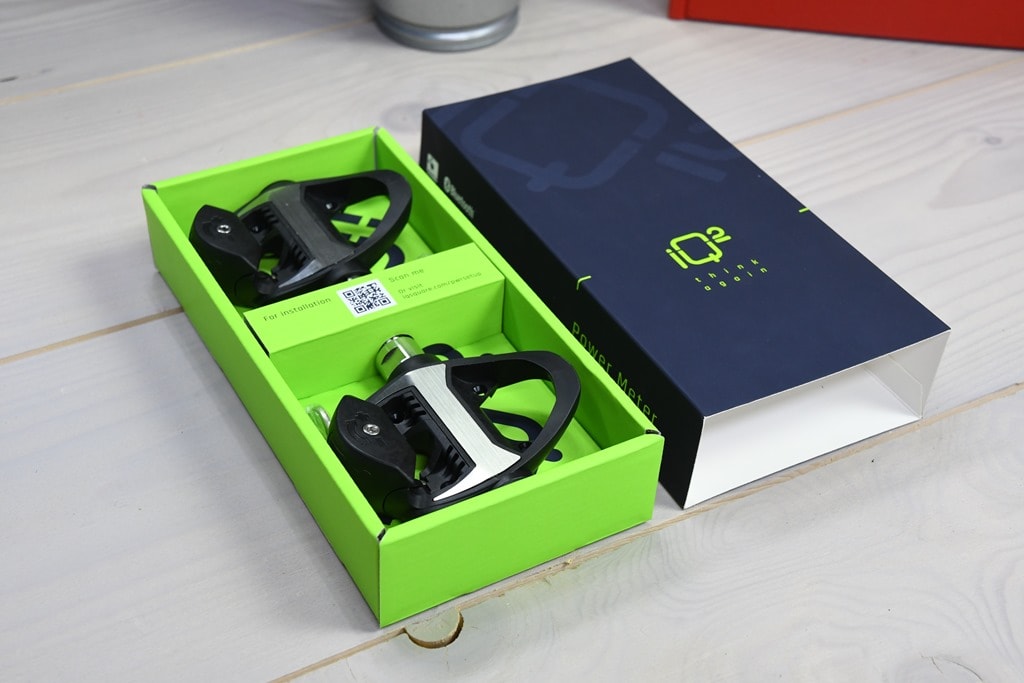
IQ2 Road bike power connected pedals
The main difference between a single-sided and dual-sided power meter is that a single-sided power meter measures only the power output of one of your legs (mostly left) and then multiplies it by two to get your total power output. For most triathletes and cyclists this is good enough for their training. If you want to be super accurate and can afford it, then the double-sided solution may be better for you.
The power pedals also provide cadence data, which is everything you need for Zwift, Wahoo, TrainerRoad etc. If you want to output speed you will need to fit a speed sensor like the section one above. If you want to show heart rate, then you will also need a heart rate monitor.
FREE DOWNLOAD: 31 Structured Indoor Workouts for Zwift, Rouvy and TrainerRoad
Rollers: Balancing Act for Improved Skills
For those seeking a challenge that goes beyond traditional stationary setups, rollers offer a unique alternative. Unlike turbo trainers that secure the bike in place, rollers allow the bike to move freely. This not only engages your core muscles for stability but also helps improve your balance and pedalling technique. While the learning curve might be steeper initially, mastering the art of riding on rollers can significantly enhance your overall cycling skills.
You can use a basic roller like this one from Snawen which costs around £165 and add a speed and cadence sensor to connect to Zwift like the spin bike solution above for the lowest cost solution. If you have power pedals you can use these to connect to Zwift, Wahoo etc.
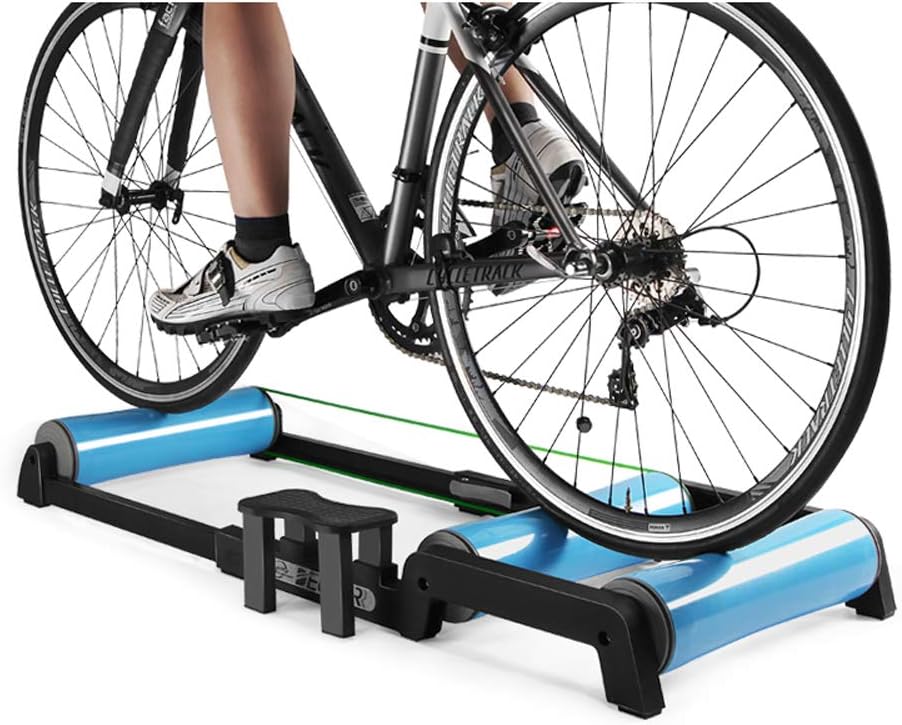
Snawen Bike Rollers on Amazon
The video below by Shane Miller explains how to connect a speed and cadence sensor to your bike to ride on Zwift.
How to use a Bike Roller with Standard Speed and Cadence Sensor on Zwift
I have used a combined speed and cadence sensor from Coospo which also have ANT+ and Bluetooth connectivity to ride on Zwift. It’s also useful to have an ANT+ dongle and cable like this one also from Coospo to connect your PC to the speed and cadence sensor. For the best Zwift experience use a heart rate monitor as well like this chest mounted one from Wahoo with Bluetooth and ANT+.
Like the spin bike option above you can also pedal with integrated power measurement like these one from Favero to ride on your rollers with Zwift.
If you are short on space or want to travel with your roller there are foldable options like this one from CXWXC (yes that is a brand!) with 5 Speed Settings.
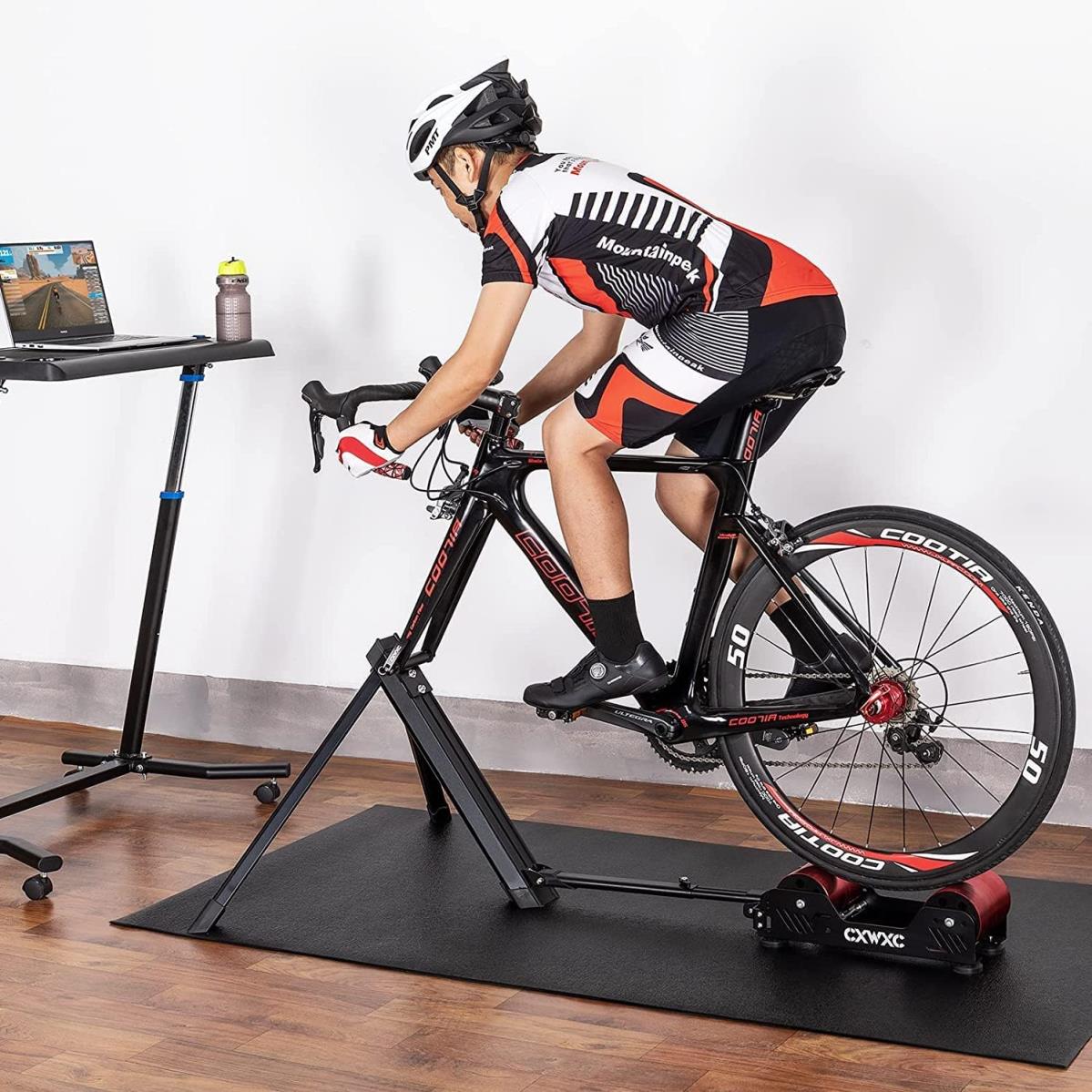
An Example of a compact, foldable bike roller from CXWXC – ideal for travelling
FREE DOWNLOAD: 31 Structured Indoor Workouts for Zwift, Rouvy and TrainerRoad
Smart Bikes: All-in-One Solution
If you're looking for a comprehensive indoor training solution, smart bikes might be the answer. These all-in-one systems combine the realism of outdoor cycling with the convenience of indoor training. Smart bikes often come with built-in power meters, adjustable resistance, and seamless integration with popular training apps. While they can be a pricier option, the convenience and features they offer make them a compelling choice for serious indoor cyclists.
Popular high end smart bikes include the Tacx Neo Bike, Wattbike Atom, Stages SB20 or Wahoo Kickr Bike and they range from £1000 to £5000.
There are however more affordable smart bikes that can be used with Zwift etc. Here is a selection of them.
Renpho AI Smart Bike
The Renpho bikes have been making waves in the indoor cycling world and their ability to connect to Zwift is well publicised. The reason that they are being talked about is the price – the Renpho bike is around £400 or less on Amazon.
It’s not the best-looking bike I’ve seen but it works with Zwift and other Apps and has automatically adjusting resistance. This bike is also making its way into popular newspapers like the Mirror – here’s their review.
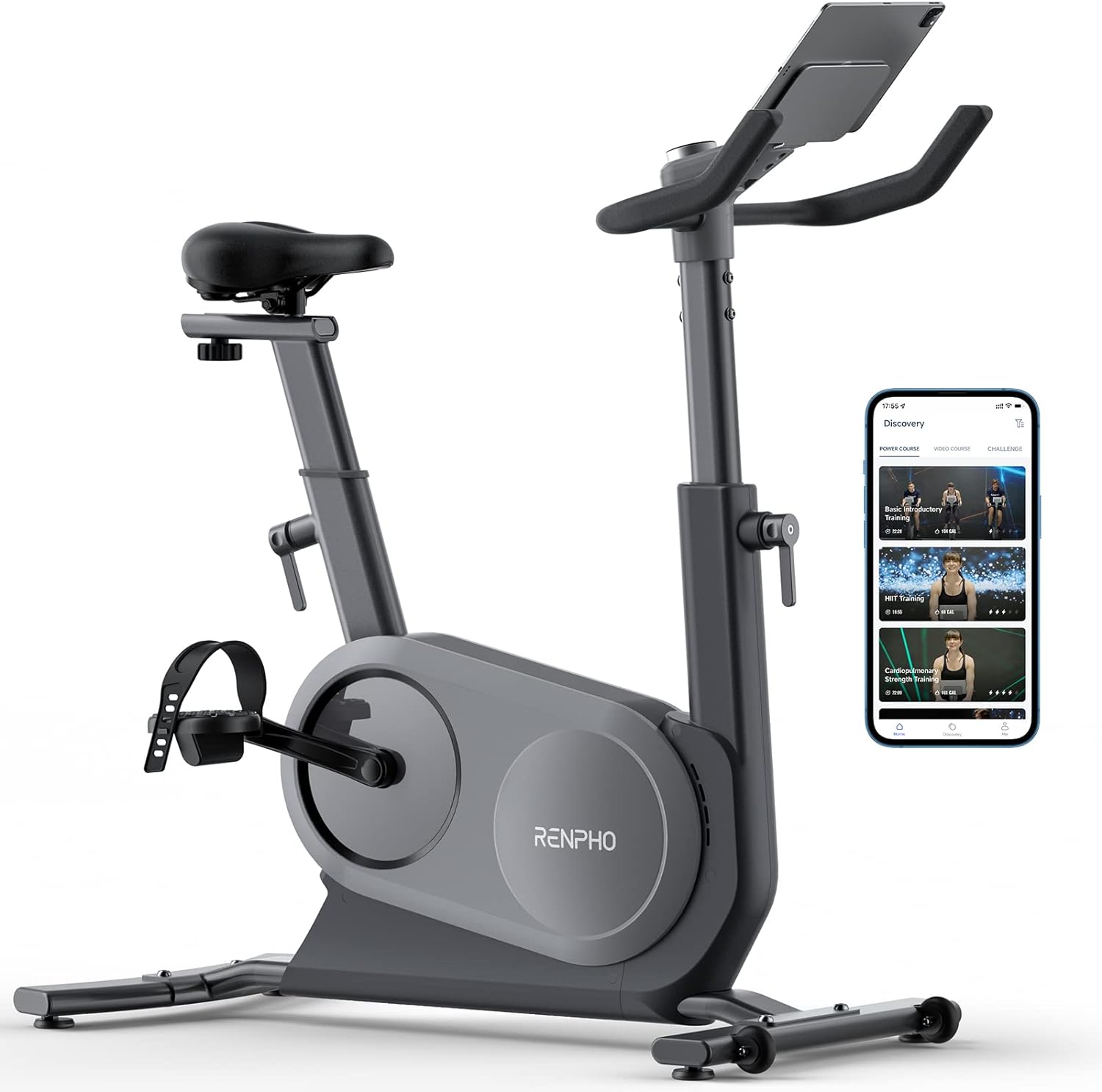
Renpho smart, connected indoor bike
VRAi Fitness SB1000X
The VRAi bike is a low-cost Bluetooth connected bike with a low-price tag of just £299 on Amazon but unlike the Renpho bike the resistance is self-adjusted. This means when you ride on an App like Zwift you will need to turn the dial to meet the speed and power targets. For me this is not a problem but if you want to know your power stats this bike is probably not for you.
The build quality appears to be good and if you are into looks it does look better than others on the market. Even though it is not officially on the supported list for Zwift etc it does work well and can send your workout stats to your App so you can track improvements.
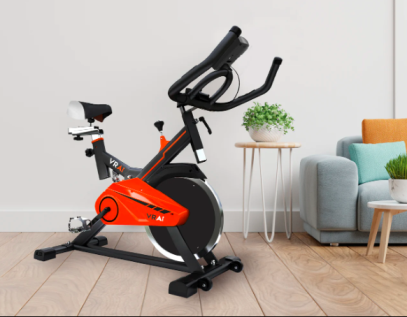
The VRAi Fitness SB100X indoor smart bike
FREE DOWNLOAD: 31 Structured Indoor Workouts for Zwift, Rouvy and TrainerRoad
NEXGIM QB-C01 Smart Bike with Bluetooth
The NEXGIM is one of the collection of smart bikes from Decathlon. It’s very similar to the Renpho bike but is at a lower price point of €299 from Decathlon. I found this bike in the Spanish Decathlon website so may only be available in Central Europe rather than the UK. Like the Renpho it has automatically adjusted resistance when connected to Apps like Zwift so for under 300 euros it is a real bargain.
You may want to replace the saddle and pedals to ones you prefer for comfort and usability.
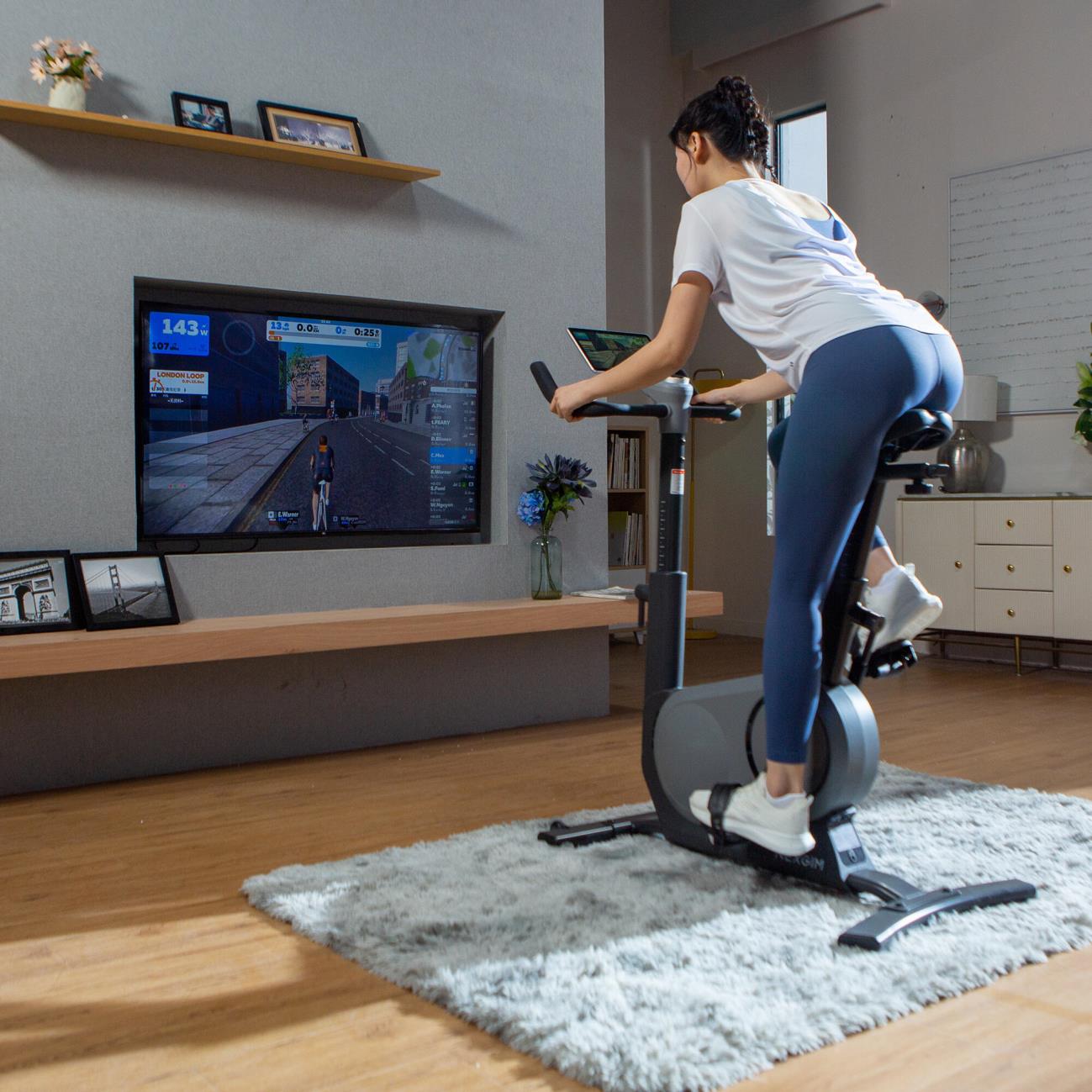
NEXGIM QB-C01 Smart Bike with Bluetooth
DOMYOS Self-Powered Exercise Bike 520
This bike from Decathlon is interesting because it is self-powered, so you don’t need to connect it to a power source to use it. This bike connects to the Domyos App and Kinomap, but I have not been able to verify if you can use it with Zwift. It costs just £299. The QZ qdomyos-zwift Appmay be able to act as bridge to connect the device if it doesn’t automatically do so. Details of the QZ App are below.
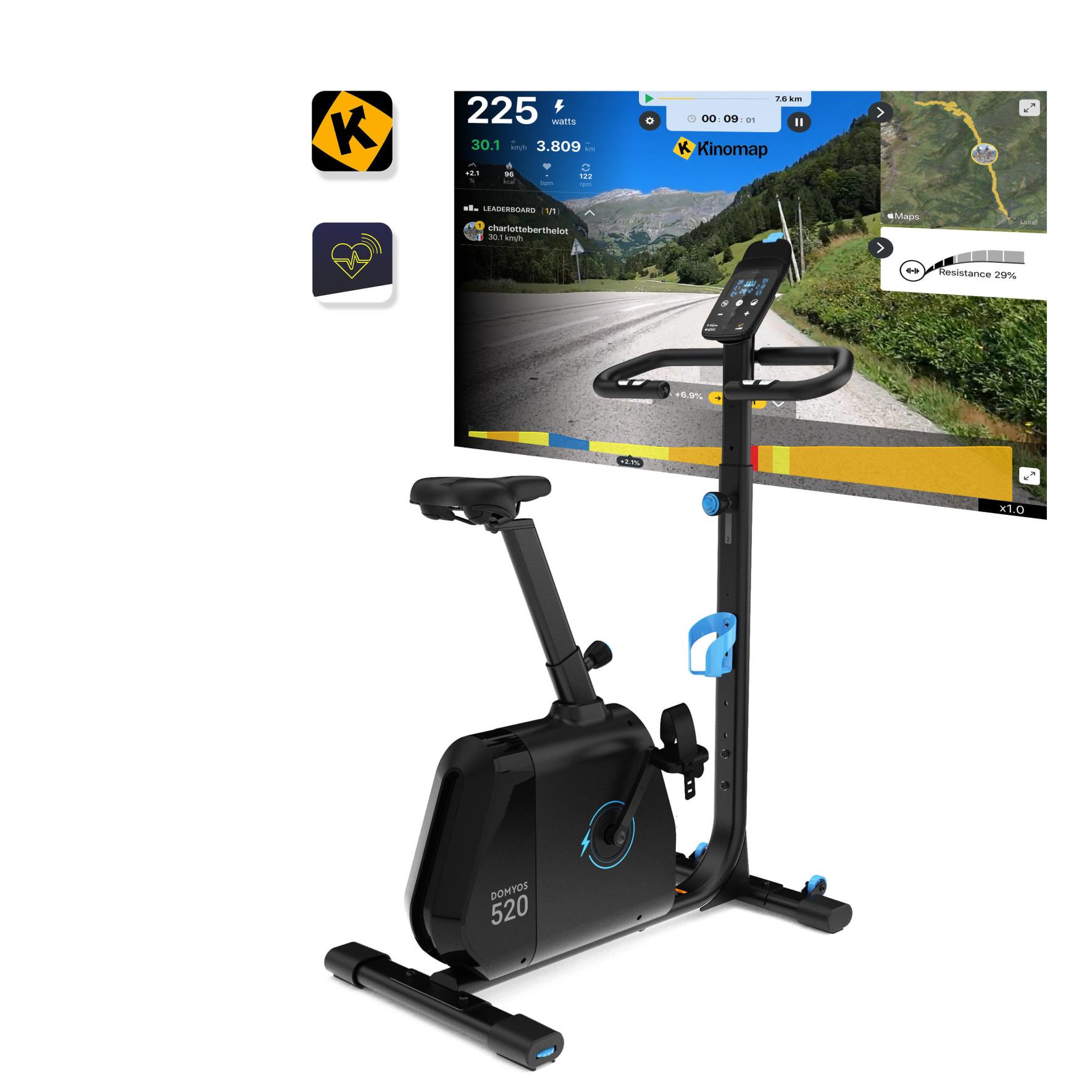
DOMYOSSelf-Powered Exercise Bike 520
Bodytone XS08 Connected Bike
This bike was €1200 and has now been reduced to €618 at Deporvillage on so one of the pricier bikes in this article so should have a good standard of features. It’s a cross between a spin bike and a smart bike so has a 24kg flywheel which will give it more of a spin bike feel and is very sturdy so it can take riders up to 150kg.
It displays speed, cadence (rpm), calorie consumption, time, distance, and power in Watts. It has Bluetooth connectivity for connection to Apps like Zwift and Bkool plus connection to your Bluetooth heart rate monitor. There’s no need to change the saddle or pedals are both are good quality with the pedals being dual sided SPD pedals so you can clip in.
You should be able to get into an aero position but the handlebars do not have drops so you can’t practice this position.
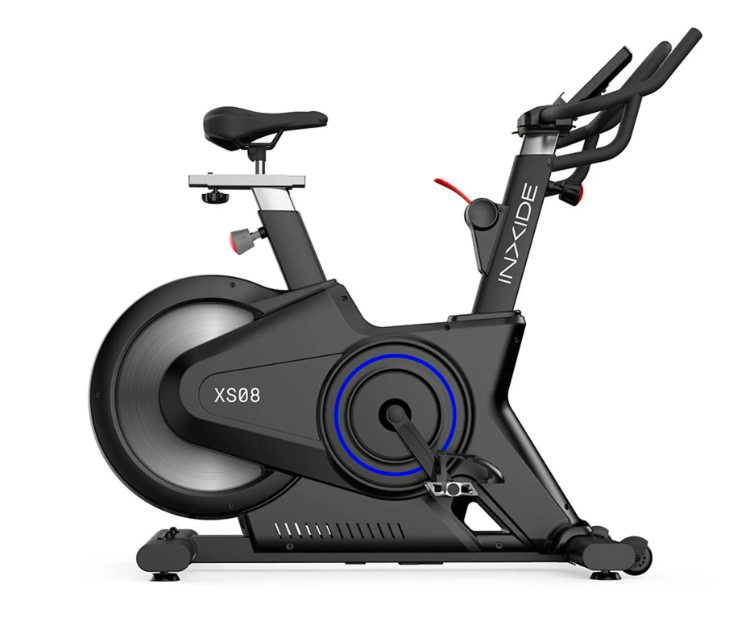
Bodytone XS08 Smart Connected Spin Bike
Sportstech ESX500
Again, this bike is like the Renpho bike in form factor, so the position is not the same as a road bike so something to bar in mind. This also means you may like to change the seat and pedal for comfort and functionality. The Sportstech website states that it has Bluetooth connectivity and works with Kinomap but does not mention Zwift.
On the Zwift forums owners of this bike have reported that it does work with Zwift and the resistance is adjusted as you ride but for the best experience use the QZ (qdomyos-zwift) app which I detail later.
This bike is currently €339 from their website. It can be used standalone with its own programs so your whole household can hop on and use it without problems.
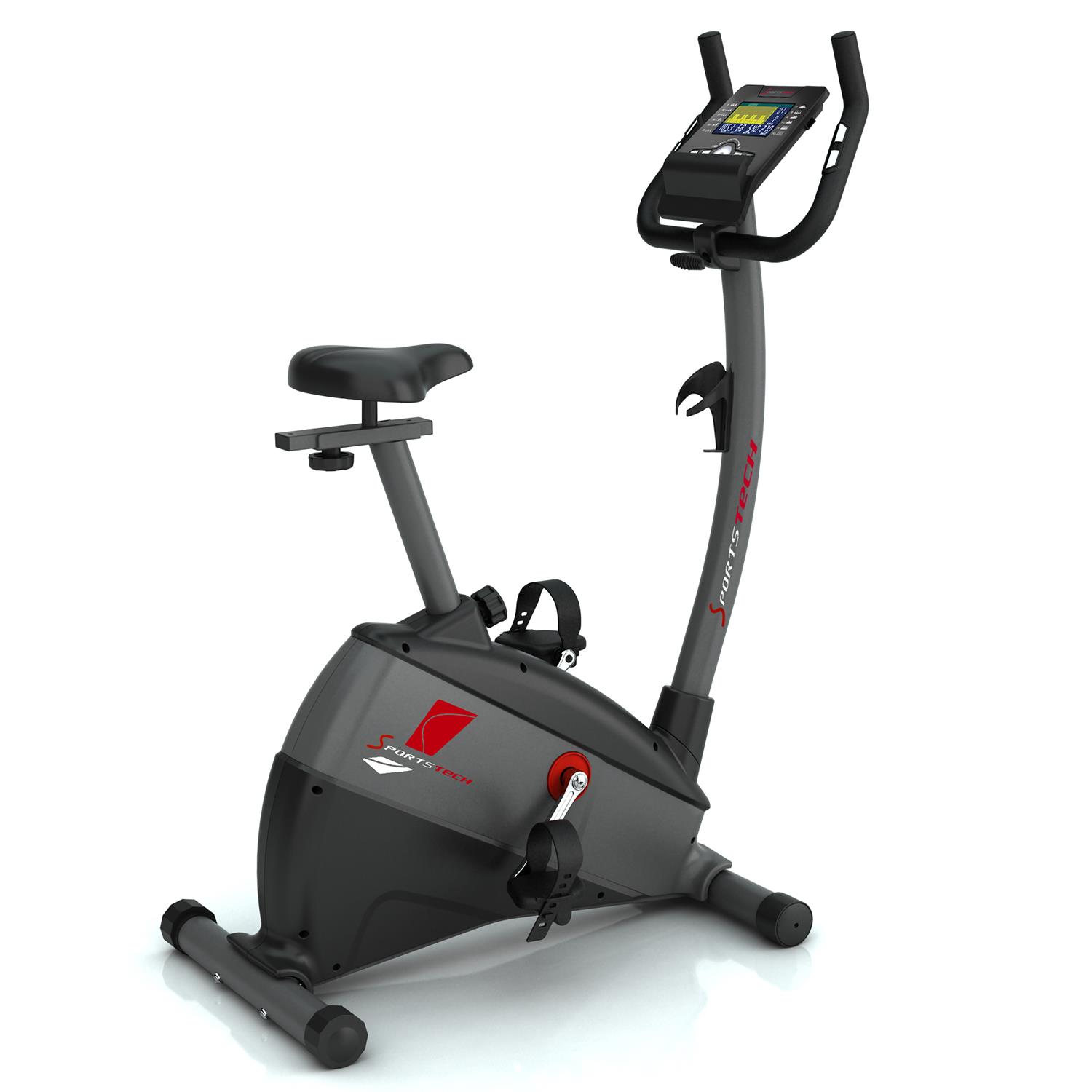
Sportstech ESX500 connected bike
FREE DOWNLOAD: 31 Structured Indoor Workouts for Zwift, Rouvy and TrainerRoad
Bluefin Fitness Tour SP Exercise Bike
The Bluefin bike is available on Amazon for £352 and comes with 2 months of Kinomap access for free via Bluetooth connectivity. It has a sturdy tablet screen holder, but the pedals and saddle may need changing to your preference. It is spin bike style bike with 25kg flywheel.
It has a heart rate monitor on the handlebars, but you may prefer to use your own heart rate monitor strap.
Users have reported that their bikes work with Zwift using the QZ App.
BluefinFitness Tour SP Exercise Bike
BH Osaka H9110
I have a soft spot for BH as they are a Spanish brand and all of my spin bikes in my all-year-round outdoor spin studio are from them, so I know they have a good build quality. The Osaka H9110 is a stunning bike and is pricier than the other bikes listed and is €649 direct from the BH website or from Decathlon.
It works with Zwift, TrainerRoad and Kinomap via Bluetooth to adjust the resistance. It has drop handlebars so rides more like a road bike. It has power settings up to 500W which is more than enough for triathletes and cyclists. It has a build in LCD display which shows distance, RPM, time, Watts, and speed plus a sturdy stand for your tablet to help you ride on Zwift, TrainerRoad and Kinomap.
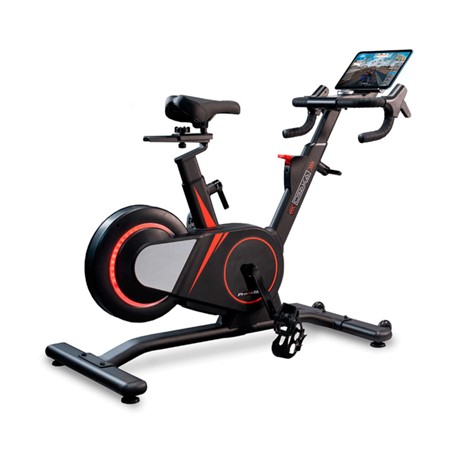
BH Osaka Connected Bike with Bluetooth
FREE DOWNLOAD: 31 Structured Indoor Workouts for Zwift, Rouvy and TrainerRoad
Zwift Compatible Indoor Bikes List on their Website
Below is a list of smart connected bikes that Zwift list as compatible with their App. These bikes are upwards of £1000 and some over £4000 so they could be an option if you have a bigger budget and prefer a static bike rather than a turbo trainer.
This list below has links to the Zwift website where you can find out more about the specific features of each bike. I have included this list for completeness and if you would prefer to cycle on Zwift with a bike from one of these companies rather than the lower cost ones detailed above.
Connecting Unsupported Bluetooth Smart Bikes using the QZ qdomyos-zwift App
For Domyos (Decathlon) and other bikes that have Bluetooth and don't automatically work with Zwift there is an App from QZ called “qdomyos-zwift”, that lets unsupported bikes connect to Zwift, Kinomap and Peloton.
The App is $5.99 and supports Echelon EX3/EX5, Proform, NordicTrack, Domyos E-Connected bikes, etc.
The App basically serves as a bridge that reads in the proprietary data transmitted by the bikes and rebroadcasts it in a format recognised by Zwift. In doing so, many bikes that were previously unsupported can now run Zwift flawlessly. This is also the option I chose, and I’m happily using Zwift on a Domyos Exercise Bike 500 with this App. There is an Apple App and Android App.
FREE DOWNLOAD: 31 Structured Indoor Workouts for Zwift, Rouvy and TrainerRoad
Using a “Dumb” Indoor Turbo Trainer for Zwift
If you have a so-called “dumb” trainer (i.e. one without Bluetooth or ANT+ connectivity or automatic resistance control) you can still get on Zwift by using a low-cost speed and cadence sensor already discussed above. For more details on how to do this read my Blog on getting on Zwift for under £85.
Conclusion: Alternative Ways to Ride Inside
As we conclude our exploration of alternatives to turbo trainers for indoor training apps like Zwift and Wahoo, it becomes clear that the world of indoor cycling has evolved beyond the confines of traditional setups. Spin bikes bring the realism of outdoor cycling to your living room, power pedals provide precise data for performance tracking and flexibility to use with all types of static bikes and rollers, rollers challenge and improve your cycling skills, and smart bikes or smart turbo trainers offer an all-in-one solution for the serious indoor cyclist.
The choice ultimately depends on your preferences, goals, and budget. Whether you crave the dynamic feel of the open road on a spin bike, the precision monitoring of power pedals, the skill development on rollers, or the comprehensive features of a smart bike or smart turbo trainer, there's an alternative that can breathe new life into your indoor training routine.
The ever-expanding landscape of indoor cycling alternatives ensures that you can tailor your training experience to match your unique needs. Whichever path you choose, the goal remains the same: to make indoor training as enjoyable, effective, and immersive as possible.
So, bid farewell to the monotony of traditional turbo trainers and embrace the diversity of options available to transform your indoor cycling sessions into exciting and rewarding adventures. Your fitness journey is about to take a thrilling turn—Ride On!
Karen Parnell is a Level 3 British Triathlon and IRONMAN Certified Coach, 8020 Endurance Certified Coach, WOWSA Level 3 open water swimming coach and NASM Personal Trainer and Sports Technology Writer.
Karen is currently studying for an MSc in Sports Performance Coaching at the University of Stirling.
Need a training plan? I have plans on TrainingPeaks and FinalSurge:
I also coach a very small number of athletes one to one for all triathlon and multi-sport distances, open water swimming events and running races, email me for details and availability. Karen.parnell@chilitri.com
Get your FREE Guide to Running Speed and Technique
Get your FREE Swim Workouts for Triathletes E-book
Get your FREE Open Water Swimming Sessions E-Book
Get you FREE 31 Structured Indoor Cycling Sessions and Training Plan
Note: Technology changes rapidly so the bikes and other technology may change over time so please also do you own research before making a purchase.
FAQ: Alternatives to Turbo Trainers for Indoor Training Apps like Zwift and Wahoo
What are the benefits of using alternatives to turbo trainers for indoor cycling apps?
Alternatives such as spin bikes, power pedals, cycling rollers, and smart turbo trainers offer a more diverse and engaging indoor cycling experience. They provide a more realistic feel, precise performance tracking, skill improvement, and, in some cases, advanced features for a comprehensive workout.
How do spin bikes enhance the indoor cycling experience?
Spin bikes offer a dynamic experience by mimicking the feel of outdoor cycling. They often come with built-in resistance mechanisms, providing a more immersive ride. Some spin bikes are also compatible with popular training apps, allowing for a realistic simulation of virtual terrains. I find them more robust when cycling out of the saddle.
What are power pedals, and how do they differ from traditional pedals?
Power pedals replace standard bike pedals and measure your power output in real-time. This data is then transmitted to training apps, offering precise tracking of your performance usually using Bluetooth. Power pedals provide a more accurate assessment of your efforts compared to traditional trainers.
What are speed and cadence sensors, and how do they contribute to indoor training?
Speed and cadence sensors are devices that attach to your bike and measure your speed and pedal revolutions per minute (cadence). These sensors provide additional data to enhance your indoor training experience, helping you monitor and optimize your performance.
Can I use cycling rollers for indoor training, and how do they differ from other options?
Yes, cycling rollers are a viable alternative. Unlike stationary setups, rollers allow the bike to move freely. This engages core muscles for stability and helps improve balance and pedalling technique. While they have a learning curve, rollers offer a unique and skill-building indoor cycling experience.
Are cycling rollers suitable for beginners, or are they better for experienced cyclists?
Cycling rollers can be used by both beginners and experienced cyclists. However, they may have a steeper learning curve, requiring riders to develop balance and control. Many cyclists find rollers to be a valuable tool for improving overall riding skills.
What is a smart turbo trainer, and how does it differ from other alternatives?
A smart turbo trainer is an advanced indoor cycling device that offers variable resistance and integrates with training apps. It can automatically adjust resistance based on virtual terrain in apps like Zwift. Smart turbo trainers often provide a realistic road feel and detailed performance metrics.
How do smart turbo trainers enhance the indoor cycling experience?
Smart turbo trainers add a layer of interactivity to indoor training. They can simulate changes in terrain, automatically adjusting resistance to mimic uphill climbs or downhill descents. This feature, combined with compatibility with training apps, makes the indoor cycling experience more engaging and realistic.
Do speed and cadence sensors work with all types of bikes?
Speed and cadence sensors are generally compatible with a wide range of bikes, including road bikes, mountain bikes, and indoor bikes. They often attach to the bike's frame or wheels, providing versatile compatibility.
Can I combine different alternatives, such as using power pedals with cycling rollers or a smart turbo trainer?
Yes, many cyclists choose to combine different alternatives based on their preferences and training goals. For example, you might use power pedals for precise data tracking in one session and switch to cycling rollers for a skill-building workout in another. Combining these options can add variety to your indoor training routine.
Are these alternatives compatible with popular indoor training apps like Zwift and Wahoo?
Many alternatives, including spin bikes, power pedals, cycling rollers, and smart turbo trainers, are often compatible with popular training apps. This allows you to sync your equipment with the virtual environments of these apps, enhancing the overall indoor cycling experience. Check that they have Bluetooth and/or ANT+ and that they have Apps listed in their feature list.
References
How to use an unsupported stationary bike with SYSTM – Wahoo Fitness Support
List of Budget Indoor Bikes with Resistance Control - General Discussion - Zwift Forums
QZ - qdomyos-zwift on the App Store (apple.com)
QZ (qdomyos-zwift) - Apps on Google Play
This website uses affiliate links which may earn a commission at no additional cost to you. As an Amazon Associate I earn from qualifying purchases. which may cover part of a cup of coffee for me to fuel my training.

